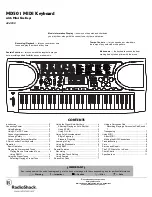
(-)
This option indicates that a “break” or release of the key is to
be done. Use this function to give the appearance of a key being
released.
ex:
[(-)Ctrl]
will emulate the deactivation of the Ctrl key.
Using the (+) and (-), the following line,
IN01:[(+)Ctrl] [F1] [(-)Ctrl]
will result in the Ctrl key being held on, the F1 key being pressed
and released, followed by the release of the Ctrl key.
(N)
Use this option to designate the key to be emulated is from
the numeric keypad section of the keyboard.
ex:
IN01:[(N)1]
is used to emulate the “1” key from the “1/
End” key from the numeric keypad section of the keyboard instead
of the “1!” key from the top of the keyboard.
(~)
This option is used to designate case sensitivity on an alpha
character.
ex:
IN01:[(~)A]
can be used to always emulate a capital A
regardless of the current Shift and Caps Lock states.
(D)
Use this option within the key sequence to suspend the KE72
and delay during the output sequence. This function is always
followed by a value which specifies a delay time X .01 seconds.
NOTE: The maximum value allowed with the (D) delay command is 250.
ex:
IN01:[(D)200]
will execute a 2 second delay (200 X .01)
Delay statements can be cascaded to produce longer delays [(D)220][(D)150]
<R>
This option is used when the input response is to be repeated
when the input is held active. The <R> must be the first text
following the : or | character on the input definition.
ex:
IN70:<R>[A]
will allow the “A” key response to repeat
9
the 0XC5 command represents the state of the first 8 inputs (bit 0
= Input1, bit 1 = Input2.....), and the second byte is the state of
inputs 9-16 etc. The 9th byte sent in response to the command is
the status of inputs 65-72 (Bit 7 = Input 72 state). A value of 1 in
a bit position indicates that the particular input is activated. The
status of the inputs is always available using the 0XC5 command
independent of whether inputs are programmed to respond with
keystrokes or serial data.
0X7F
- Status LED Read Command. Sending 0X7F to the KE72
serial port results in the return of a character in the range of ASCII
“0” - “7”. The KE72 response character reflects the current state
of the Caps Lock, Num Lock, and Scroll Lock LEDs.
“0”
-
No LEDS On
“1”
-
Scroll Lock LED on only
“2”
-
Num Lock LED on only
“3”
-
Scroll Lock LED and Num Lock LED on
“4”
-
Caps Lock LED on only
“5”
-
Caps Lock LED and Scroll Lock LED on
“6”
-
Caps Lock LED and Num Lock LED on
“7”
-
Caps Lock, Scroll Lock, Num Lock LED all on
The serial port on the KE72 may additionally be used to load a
configuration file into the KE72 as described in the “Loading a
Configuration File to the KE72” section of the manual. When
loading the configuration from the serial port, the PC running the
load program can be a different machine than the one which has
the KE72 attached to it’s keyboard port.
18











































